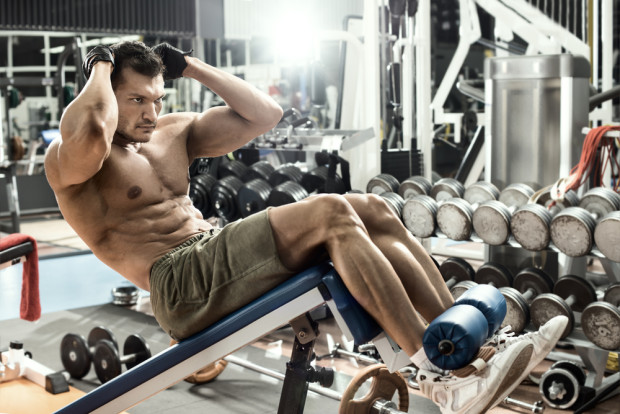


Having strong wrists and forearms is extremely valuable in many sports. Wrestling heads the list, of course, but also baseball, lacrosse, tennis, football, bowling, volleyball and strongman events as well as the shot put, hammer throw, discus, javelin, pole vault and many more. Strong wrists and forearms are assets in the weight room as well, for they help you handle heavier weights on a great many exercises, from power cleaning and snatching to benching and inclining. If your wrists and forearms are weak, the power generated by your chest, shoulders and arms will not be transferred adequately into the bar.
Most people believe that they need an extra-strong grip in order to move heavy weights on the two Olympic lifts, the clean and the snatch, and on the deadlift, but that isn’t true. By using a hook grip, you can lock onto a bar as tightly as you can when using straps. Even so, keeping your wrists and forearms strong will help prevent them from being injured, which is a good thing, as the list of exercises that can be done drops drastically with that kind of injury. A hurt wrist usually means dropping all free-weight exercises and switching to machines.
The good thing about working the wrists and forearms is that it doesn’t require much in the way of equipment. A barbell and dumbbells will get the job done. These exercises can be worked separately, at night or on the days that you don’t train.
I’ll start with an apparatus that you can make rather easily and is very the best exercise for improving strength in your wrists and forearms—the wrist roller. All you need is a length of round wood, about a foot and a half. A thick broomstick will work or a fat dowel. Drill a hole in the center, insert the end of a piece of clothesline through it, and tie a knot to secure the rope. The clothesline must be long enough that when you extend your arms straight forward, it will touch the floor. Attach a five- or 10-pound plate or a dumbbell to the end of the clothesline, and you’re good to go,
Using an overhand shoulder-width grip, hold the piece of wood directly out in front of you. Lock your elbows. The weight should be touching the floor. Now roll the weight upward until it touches the wood, then slowly roll it back down to the floor. Repeat without any hesitation. Do not allow your arms to drop, and do not jerk the weight around. Both the up and down movements must be done in a smooth, controlled manner.
The first time people try these, they typically can manage two ups and two downs. That’s okay. As with any other exercise it doesn’t matter where you start; it’s where you end up that counts.
The most that I’ve seen done is six ups and downs. You can do these often, and they’re only productive when you push them hard. Working the wrists and forearms is much like working the calves. You have to abuse them to make them stronger. I recommend doing wrist rolls three times a week, at night or on nontraining days. You’ll never consider them a fun exercise, but if you work them hard enough, they’ll get the job done.
There are several other exercises that are specific for the wrists and forearms and work very well. Hammer curls and reverse curls are two of the best and favored by bodybuilders because they add size to the forearms. Hammer curls are performed with your thumbs up, so you must do them with dumbbells. Reverse curls, on the other hand, can be done with dumbbells, a straight bar, or an EZ-curl bar. I prefer a bar because you can use more weight.
Wrist curls are another favorite of strongmen and bodybuilders and have been since Milo lifted that calf. There are two ways to do them—palms up and palms down. You can do them one arm at a time with a dumbbell or together with a straight or EZ-curl bar.
I’ll start with the straight bar. Sit on the edge of a chair or bench with your palms up. Place your forearms on top of your quads with your wrists extended over your knees. Grip the bar tightly and bend your wrists as far down as you can while keeping your forearms snug to your thighs. From there curl the bar upward as high as you can. Keep doing this motion until your wrists and forearms are screaming for you to stop.
Now switch so that your palms are down, and do the same up-and-down motion. Do three sets, to limit, and either add weight or increase your reps each time you do them. Don’t increase it by much, however. Five more pounds and/or a couple of reps is enough.
After you’ve been doing the palms-up version for a few weeks, try this: Instead of maintaining a tight grip on the bar, let your fingers open, and roll the bar down them until you can just barely hold on. Then curl your fingers back together, and complete the curling motion. This subtle, extra move forces your wrists and forearms to work even harder, which in return results in more strength.
If you choose to use dumbbells for wrist curls, set your elbow on one knee and your palm on the other to form a bridge. Hold the dumbbell across the back of your bracing hand and commence to do the exercise. Then switch over and do the palms-down version of the movement. By doing these with dumbbells, you will quickly discover which wrist is the weakest. Add a couple of extra reps or even another set for the weaker wrist, and in a few months it will be up to par.
Another productive exercise for your wrists and forearms involves locking a weight to the end of a short bar. An adjustable dumbbell bar is okay for starters, but as you get stronger, a longer bar works better. Hold the bar by the side of your leg with the weight hanging straight down. Elevate the bar upward with your wrist and forearm until it’s pointing up, and then slowly lower it to the starting position. Repeat until you’re no longer able to raise the weight vertically.
A variation of that exercise is to let your arm move freely and bring the weight upward in a few different angles. That works the muscles of your forearm and wrist a bit more than when your arm stays snug to your side. Try both versions, and see which makes you work harder. Harder is always a good thing.
Do these for three sets per arm, and slowly but steadily add reps and/or resistance.
A popular wrist and forearm exercise in the York Gym was the weaver stick. It was also a test of strength. The weaver stick is a six-foot length of broomstick, with a short piece of clothesline and a weight attached at the other end. Just as in the previous exercise, you lock your arm next to your leg, and bring the stick up to a horizontal position.
Vern Weaver, Val Vasilef, Ernie Pickett, Bob Bednarski, Bill March and John Grimek were all exceptionally strong, but no one could match Steve Stanko. Whatever a challenger did, Steve always did five or 10 pounds more.
Hand grippers used to be very popular with those wanting greater gripping strength, and they still work—as does the old tried-and-true method of squeezing a rubber ball. I found that a ball of trainer’s tape works as well. The nice thing about squeezing a rubber something is that you can do it just about anywhere—while driving, or waiting in the dentist’s office, or watching TV or even while reading.
So there are plenty of exercises for you to choose from if you want to improve your wrist and forearm strength. Pick out one or two, and work them hard. Keep in mind that some laborers work their forearms for eight hours a day, and the results are very obvious.
Editor’s note: Bill Starr was a strength and conditioning coach at Johns Hopkins University from 1989 to 2000. He’s the author of The Strongest Shall Survive—Strength Training for Football, which is available for $20 plus shipping from Home Gym Warehouse. Call (800) 447-0008, or visit www.Home-Gym.com.






















You must be logged in to post a comment Login